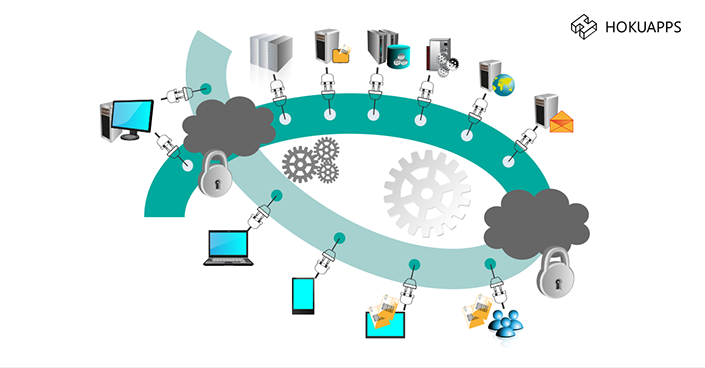- Products
- Solutions
- Services
- Resources
- Customer Success
- Company
- Sign In
- Contact Us

Enterprise Resource Planning (ERP) streamlines an organization’s critical capabilities by realigning unorganized processes. SAP, the largest ERP solutions provider, enables linkages between distinct data silos and facilitates its visibility across the business. In addition, enterprises can gain real-time insights by leveraging the SAP Cloud platform which helps in enabling data-driven decisions.
Since SAP has a wide spectrum of solutions catering to different digital workflow requirements, it becomes a critical component for the smooth running of operations. However, the SAP integration process varies across industries as each consists of a distinct set of processes. For instance, a manufacturing company’s workflow management will differ from that of an insurance firm.
Consequently, the approach adopted for SAP integration will vary considerably. Again, processes will also vary depending on the SAP and non-SAP applications in use. This is critical as the right SAP integration technique not only automates business workflows but also provides an interconnected landscape that helps gain a competitive edge. Hence, integration with SAP is not a choice, but a necessity.
To deliver cohesive business operations and meet business needs, SAP integration is essential for exchanging data and content between systems and applications. There are several SAP integration services offered within the Cloud Platform. So many a time, the question is when to use which tool. This blog explains the different SAP integration services features available. It also discusses the typical use cases.
Use cases help in understanding scenarios necessitating SAP integration to streamline processes.
Enterprises using multiple applications and third-party systems must plan SAP integration within their processes to streamline workflow. To deliver future-proof SAP integration competencies, it is essential to have a complete understanding of the applications’ characteristics and SAP integration requirements. Research shows that companies have earned about 48 percent higher revenue with SAP integration.
Before your business grows too complex for your IT, we can help you see, think and act clearly. We promise to offer SAP integration solutions to cater your business management challenges. Our know-how spans sales and customer relationships to financials and operations, so that companies can streamline key business processes, have access to timely information and grow profitably. Our SAP expertise extends to the latest mobile, cloud and in-memory computing technologies.
Scenarios where SAP integration is critical include:
Conventional business enterprises compartmentalize CRM and SAP as different entities. While CRMs manage customer interactions and sales support, SAP handles the back-end processes of billing and shipping. Today, organizations are struggling to accommodate transformative changes in the current business ecosystem, and stay ahead of the curve. This is facilitated by robust tools from the SAP suite which helps businesses gain a better understanding of their customers. Through holistic visibility of customer data enabled by SAP integration, customer relationships are enhanced, and businesses remain competitive.
The best possible way to explain the workings of this cloud-centric model is an example. Let us assume that a business partner already exists in the SAP ERP system. Therefore, in order to transfer data to a CRM software, SAP creates an intermediate document or an IDoc (an SAP object that enables the transmission of business transaction data from one system to another) with an updated partner profile that contains the partner’s name, surname, address and contact details. The IDoc once triggered in SAP thus transfers the information electronically from one system to another.
As for new customer information, when it is entered into the CRM structure, it becomes automatically available to other business functions in SAP across the company. Thus, this is essentially a two-way process whereby information created in SAP is readily available in the CRM structure and vice versa thereby allowing for the possibility to import or migrate all kinds of data, especially data related to business partners, contacts, opportunities or offers in the SAP Business suite.
Organizations need to connect SAP with its supplier systems to streamline processes involving purchasing and shipping. For instance, a manufacturer is constantly in communication with various suppliers. He would need clear visibility on the purchase requisition and supply-chain visibility to reduce the lead time for procuring raw materials. System integration comes in handy here as it allows the manufacturer to keep track of the quality of purchased components.

Thus, exporting and importing data through ERP integrations can significantly enhance the functionality of your manufacturing system. In case of supplier management, missing out on SAP integration opportunities can leave your manufacturing ERP systems in the dark.
ERP to Supplier: Supplier integration involves some simple and obvious data. For example, do you have up-to-date contact information? This is because, if the automated emails intended for the supplier are being received by someone who is not the intended recipient then your ERP integration is most likely to fail. Other factors that need to be taken into account in this integration process is the lead time for every item you order and where the item is manufactured. This is important since it directly impacts the SAP integration process.
Supplier to ERP: Receiving data from your supplier is equally important as the data is sent by the ERP system to them. For instance, you ordered a circuit board with an integrated circuit and additional components and your bill of materials might specify a certain component you have always used in the past. Your supplier, on the other hand, may have a source in place already for a generic component that has been competently used for years at a lower cost. Therefore, missing an opportunity like this can significantly reduce the potential for a successful ERP implementation.
To streamline the process of creating, approving, scheduling, and managing purchase orders (POs), SAP integration with third-party PO systems is critical. Transparency between the two enables organizations to promptly send POs and receive on-time replies. Transparent communication helps buyers gain adequate control over the spending practices.
The three key benefits of integrating your inventory management software with your accounting and back-office systems are:
§ Optimizing inventory to meet product availability and ROI goals
§ Providing inventory visibility to supply chain partners
§ Stating inventory accurately in financial reports
Although there are various benefits of SAP integration between inventory and back-office systems, these three can have a significant impact on your company’s bottom line.
Inventory and back-office system integration must be real-time, flexible, transparent to users, reconcilable and scalable. Being able to provide real-time reports, you can facilitate transparency to your customers and supply chain partners. This ensures that your financial reports are updated and accurate.
Thus, integrating inventory and back-office systems is a critical function. However, transformations in business processes and occurrence of discernible errors affect the integration process. Also, mitigating scalability issues are often ignored during the integrated design process. This is not recommended as it negatively impacts your company during high transaction volumes.
So why integrate purchase software with your back office?
When selecting ERP solutions businesses often find themselves encountering the impacts of an ill-planned architecture that essentially handles the short-term tactical needs. In the process, the company’s efforts to scale up is highly impacted. Therefore, depending on the severity in terms of impacts, such inefficiencies eventually restricts the scope for growth.
Non-Value Added Activities:

If your employees have to navigate through inefficient and disjointed processes, it automatically makes them prone to errors and shifts their focus from their core responsibilities. Key business functions such as order processing, invoicing, expense approvals and fulfillment can take longer to accomplish if businesses fail to automate processes. For instance, a set of employees may be spending hours re-entering order information manually into the accounting and invoicing system, while another set may pull that same information directly from the CRM system for order fulfillment processes and calculating sales commissions. This, in turn, expedites the transaction process and improves visibility into cash flow. In the meantime, if orders are canceled employees manually entering order information will have to sift through mounds of data to repeat the process of reconciling this information. The time lost can prove to be detrimental when trying to improve the profitability of your business.
When software systems are not integrated, you have multiple overlapping databases and you also cannot get deeper insights into business performance in a timely fashion. Reports pertaining to the finance, sales, and marketing, service and fulfillment departments are crucial to give an integrated view of a company’s operations. Most companies, as a result, simply end their pursuit of acquiring this information because of the time it takes the source, extracts and analyzes this data.
For those that do not, countless hours are spent trying to integrate unrelated, error-prone and out-of-date information together. Consequently, companies gradually end up making critical business decisions based on inaccurate information.
Customer acquisition and revenue growth are the key pillars to a company’s continued success. Amid fierce competition, it is essential that a company continues to provide exceptional customer service experience or risk losing customers to competitors. This, in turn, will accelerate your customer churn rate. When customers are unable to access critical information it adversely affects customer satisfaction and loyalty. You fail to lock their loyalty and ensure repeat business. An integrated software system ensures that customers have the right information and customer experience they deserve with access to a real-time self-service portal. Thus by allowing employees instantaneous access to all customer interaction and transaction, they will be able to outperform their competition.
Companies across industries are already reaping the manifold benefits of SAP integration. SAP integration ensures effective communications between the SAP and non-SAP applications, facilitating a transparent and efficient administration with a robust integration platform. With SAP office integration, businesses have lowered costs by up to 300 percent.
HokuApps is here to assist you in your digital transformation journey. A leader in deploying SAP integration solutions, we help you connect your business processes and streamlining operations. Click here to know more!